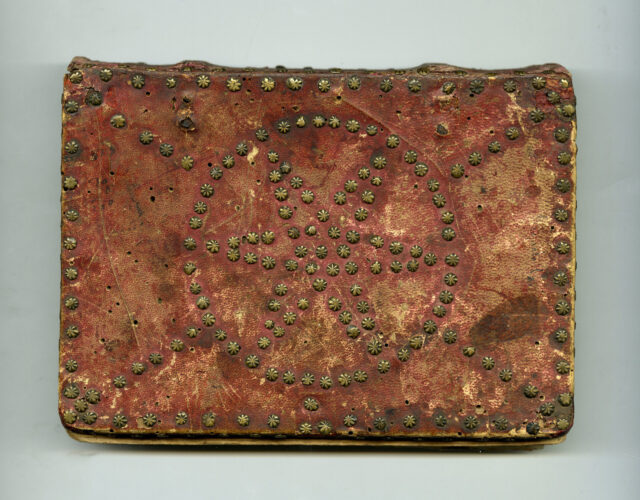A manuscript of recipes written in the first half of the 15th century raises certain expectations: how to stew tripe perhaps or make a tart out of borage flowers. But this manuscript is more Harry Potter than an early Cook’s Illustrated.
The 437 nails hammered into the red leather cover hint at the strange, by our standards, mix that lies inside Recipes and Extracts on Alchemy, Medicine, Metal-Working. . . . To be fair there are recipes for making wine, but that’s as close as these pages come to modern cooking. However, if you’re looking for a recipe to make a dying horse look fat and beautiful, or if you want to get rid of fleas, purify mercury, or even force evil beasts from your home, then this is the manuscript for you.
The cookbook is one of nine alchemical manuscripts acquired by the Science History Institute. One is made of parchment, while the other eight are made of well-preserved paper, which just goes to show that modern paper makers have something to learn from their 15th- and 16th-century counterparts. The manuscripts were written in Italy, Spain, Germany, England, and France; together they make up a world-class collection of alchemical texts now housed in the Othmer Library.
Printing came to alchemical works late. Even when print became commonplace, printers did not expend much effort on early alchemical books. Worse, they were lackadaisical in matching the book to the handwritten manuscript from which it came. For example, the first printed edition of The Precious New Pearl, a treatise by 14th-century alchemist Petrus Bonus, did not include the contents of the whole manuscript. For that reason the most significant work within the new collection is a 15th-century manuscript version of The Precious New Pearl, of which there are only six copies in the world. These copies can be merged to essentially re-create the missing 14th-century original.
Few alchemical manuscripts from the Middle Ages have survived, probably because they were used like cookbooks—taken into the alchemical laboratory where they suffered from the slings and arrows of alchemical misfortune. The lone parchment manuscript, a 15th-century miscellany of alchemical works, shows heavy use and soot marks, likely evidence of some serious lab time. The manuscript includes extracts from the work of 14th-century Franciscan friar and alchemist Johannes De Rupescissa and drawings of alchemical instrumentation.
All nine manuscripts come from the collection of Dutch businessman Joost R. Ritman. Fortunately, Les Enluminures, the gallery selling the manuscripts, preferred that they go to a library and that the collection stay in one piece. The manuscripts are already being put to serious scholarly use and will probably appear in an upcoming museum exhibition at the Institute. Now that the Sciehas a core collection of alchemical manuscripts, it’s likely more manuscripts will accrete around this core, rather like an alchemical form of gravity. (A first-edition copy of Newton’s foundational work on gravity, the Principia, is also part of the Institute’s rare-book collection.)




